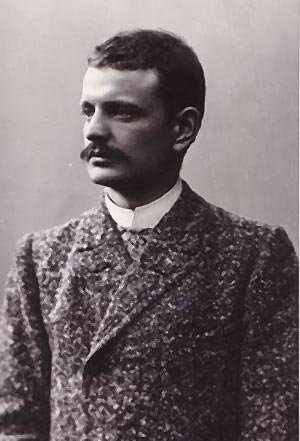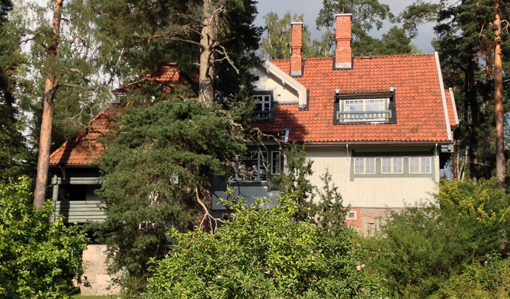
Jean Sibelius was born in Hämeenlinna, Finland, on 8th December 1865, the second of three children. His father died when ‘Janne’ was only two. Although the language spoken at home was Swedish, Janne attended Hämeenlinna’s pioneering Finnish-speaking grammar school. Music was encouraged at home, and before long Janne was improvising and composing pieces of his own. Vattendroppar (Water Drops) for violin and cello (c. 1875) is believed to be his first surviving composition. In 1885 Janne finished school and moved to Helsinki, nominally to study law, although he also enrolled at the Music Institute. It was not long before the law studies were quietly dropped, and he started official composition studies under Martin Wegelius. His music from these years displays a seemingly inexhaustible melodic fecundity as well as an increasingly secure and original sense of form.
It was during his student years in Helsinki that Janne – now using the ‘music name’ Jean – met and fell in love with Aino Järnefelt. He numbered many future luminaries of Finnish culture among his friends, among them the authors Adolf Paul and Juhani Aho. He also befriended the composer and conductor Robert Kajanus and the pianist and composer Ferruccio Busoni.
In 1889 Sibelius left Finland to pursue his studies abroad – first in Berlin and then in Vienna. In both cities he lived far above his means and enthusiastically nurtured a taste for fine wines and cigars. It was at this time that he became fully aware of the potential of the Finnish epic poem, the Kalevala, as a source of musical inspiration. He was soon hard at work on a massive five-movement piece for soloists, male choir and orchestra with a Kalevala text: Kullervo. Back in Finland, Sibelius conducted Kullervo to great acclaim in April 1892. The work marked his breakthrough and smoothed the way to his marriage to Aino that June.
The 1890s were a time of increasing political discontent in Finland. Although it was nominally an autonomous grand duchy of the Russian empire, the country’s powers of self-determination were gradually being eroded by a series of Russian decrees and manifestos. The reaction to such measures was defiant, not least in cultural circles. Sibelius produced a series of works that helped to confirm his position as the foremost musical champion of the Finnish nationalist cause. He was also a regular customer at Helsinki’s most fashionable watering holes, where he and his colleagues spent many an evening and night drinking and philosophizing. Works such as En saga, Karelia, Skogsrået (The Wood-Nymph), the Lemminkäinen tone poems (including The Swan of Tuonela) and the Press Celebrations Music (including Finlandia) all date from this period, though many were later substantially revised. Sibelius dabbled with opera and with Wagner – and even visited Bayreuth in 1894 – but ultimately found that Wagner’s music repelled him as much as it attracted him. Sibelius’s only complete opera is a one-act piece, Jungfrun i tornet (The Maiden in the Tower) from 1896. An attempt that year to secure a teaching position at Helsinki University failed, but in 1897 Sibelius was awarded a small state scholarship. This by no means freed him from financial worries: indeed, he spent money so freely that he would remain in debt for several decades to come.
Just before the turn of the century Sibelius made his mark in two further genres. His first major theatre score was the music for Adolf Paul’s historical drama Kung Kristian II (King Christian II; 1898). The second genre was the symphony: his First Symphony, a pivotal work in Sibelius’s career, was premièred in Helsinki in 1899.
With the Second Symphony and Violin Concerto, Sibelius took his leave of the grand, national romantic style. The death of one of his daughters, Kirsti, from typhus in 1900 came as a profound blow, and the following year, while working on the Second Symphony in Italy, he came close to losing another daughter to the same disease. One of Sibelius’s most popular pieces, Valse triste (1903), started life as incidental music for the symbolist play Kuolema (Death).
The composer made the decision to move out of Helsinki, to Järvenpää. Here, in September 1904, Sibelius and his family moved into a villa built expressly for them and named Ainola after the composer’s wife. He had by then acquired a new confidant – Axel Carpelan – whose advice and support would help to sustain Sibelius through many a trial.

After his move to Ainola, Sibelius’s music acquired a more concise, classical tone, clearly demonstrated in the Third Symphony (1907). He was not greatly drawn to conventional religious music but preferred to express his deeply held pantheistic convictions in works such as the songs Höstkväll (Autumn Evening, 1903) and På verandan vid havet (On a Balcony by the Sea, 1903).
A few years later a throat tumour was diagnosed and, although it was removed in 1908, Sibelius had to abstain from cigars and alcohol for some years. It is often said that the predominantly dark mood of Sibelius’s major works from the ensuing years – among them the Fourth Symphony (1911) the tone poems The Bard and Luonnotar (both 1913) the string quartet Voces intimae (1909) and the Three Sonatinas for piano (1912) – is a by-product of his fear of a recurrence of the cancer. At any rate the bleakness of the Fourth Symphony came as a shock to his contemporaries.
In 1914 Sibelius paid a triumphal visit to the United States, where he conducted the première of the tone poem The Oceanides. Sibelius would have been keen to visit the USA again – but the First World War intervened. As much of his music was published by German firms, his income dwindled to a trickle, and for the next few years he had little option but to remain at home. Local publishers had a steady demand for short instrumental works and songs – and Sibelius did not disappoint. He turned once more to cigars and alcohol as stimulants, first in moderation but then with increasing compulsion. The major work from these years was the Fifth Symphony, which appeared in its original four-movement form at Sibelius’s fiftieth birthday concert in 1915 but was soon withdrawn for revision.
By the time he was fifty Sibelius was already an iconic cultural figure in Finland, and was a highly respected composer internationally as well. Nonetheless, the Sibelius family had to seek refuge in Helsinki during the civil war that followed Finland’s declaration of independence in 1917. Meanwhile the Fifth Symphony was going through extended labour pains. A revised version (1916) had also been withdrawn, and it was not until 1919 that Sibelius was happy with it.
The Sixth and Seventh Symphonies strike out yet again in new directions. The modally coloured Sixth (1923), is predominantly gentle and poetic, whilst the Seventh (1924), originally named Fantasia sinfonica, is a noble single-movement edifice that encapsulates and crowns Sibelius’s symphonic achievement.
After the Seventh Symphony Sibelius composed two more major works, the incidental music to Shakespeare’s play The Tempest (1925) and the tone poem Tapiola (1926), before launching into a monumental struggle with his Eighth Symphony. Expectations were running high – but old age brought an increasingly rigorous self-criticism and, in the end, Sibelius admitted defeat. In the mid-1940s he burned a number of manuscripts and, as far as we can tell, the Eighth Symphony was among them.
The term ‘the silence from Järvenpää’ has been coined to describe the composer’s later years at Ainola, but in fact he continued to make occasional revisions and arrangements as well as playing host to innumerable visiting musicians, dignitaries and family members. Jean Sibelius died peacefully at home on 20th September 1957.
Sibelius’s character displays numerous of contradictions. On the one hand he was a solitary nature-lover and pantheist with a special fascination with the great migrating birds such as swans and cranes and a profound need for the isolation of the Finnish countryside. On the other hand he was a gregarious socialite who mixed easily in high society and thoroughly enjoyed being the focus of attention in great cities throughout Europe and on his one visit to America. His relationships with his wife Aino and with close artistic associates such as Robert Kajanus could be tempestuous, but were founded on a deep and enduring respect that allowed them to survive the various crises.
In an interview in 1948 Sibelius offered the advice to younger composers: ‘Never write a superfluous note; every note must live’. His music presents compelling proof of how he himself applied this principle throughout his long and distinguished career.
© Andrew Barnett 2006/2014
A longer version of this biography is available in the Members’ Area.
We always remember Jean Sibelius. My Finland visit I visited Sibelius monument. I am writing about Jean contribution to my Finland traveloge book in Malayalam language, Kerala, India. Thanks.
There is no other composer like Sibelius: Vaughan Williams said of him that he could make a common chord like C Major sound uniquely his own. A wonderful example of this may be found in “Snofrid” – following an orchestral and choral introduction to the work there appears a recitative for a single speaker, and once that ends there appears a most wonderful chord which immediately precedes a continuation of choral and orchestral writing, leading to a conclusion of great power. This chord proves Vaughan Williams to be right. I urge those interested to listen to it.
Jim Wakeford